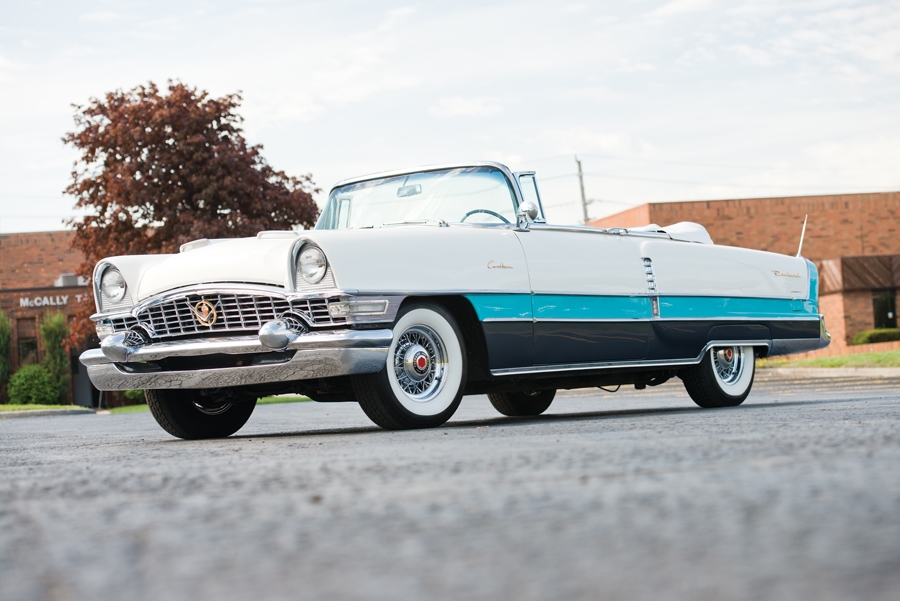Packard’s last prestigious, low-production offering was the Caribbean convertible of 1955 and 1956. This top-of-the-line model was completely redesigned for ’55, and it sported a new high-output overhead-valve V8 engine with dual four-barrel carburetors, which could produce an amazing 310 horsepower, put to the rear wheels through a new push-button Twin Ultramatic transmission. An innovative, new torsion-bar suspension on the chassis featured automatic leveling to suit the road surface, making the 1955 Packard Caribbean the smoothest-riding and best-handling full-size car of its era.
At $5,932, the Caribbean was breathtaking in more ways than one. Perhaps unsurprisingly, Packard built a mere 500 examples in 1955. The survivors are treasured by enthusiasts of 1950s automobiles and are known as “the last great Packards,” with some even saying that they are the finest luxury convertibles of their era.
SCM Analysis
Detailing
| Vehicle: | 1955 Packard Caribbean convertible |
| Years Produced: | 1955 |
| Number Produced: | 500 |
| Original List Price: | $5,932 |
| SCM Valuation: | $70,000–$85,000 |
| Chassis Number Location: | Plate attached to left front door post |
| Engine Number Location: | Boss upper left side of engine block |
| Club Info: | Packard International Motor Car Club |
| Website: | www.packardsinternational.com |
| Alternatives: | 1953 Buick Skylark, 1955 Cadillac Eldorado convertible, 1956 Lincoln Premiere |
| Investment Grade: | B |
This car, Lot 112, sold for $66,000, including buyer’s premium, at RM’s Motor City auction in Plymouth, MI, on July 26, 2014.
Packard built their first car in 1899. Having survived the Depression and the after-effects of World War II, their last true Packard rolled off the assembly line on June 25, 1956.
Their demise — stemming from a bit of bad luck and a healthy dose of mismanagement — is the topic for a business-school case-study. The plain and simple explanation is that, after World War II, Packard conceded the luxury-car market to Cadillac and instead concentrated on the volume mid-market. Some say that their senior-model body dies had been left out to rust and were unusable, while others say that Roosevelt had given those same dies to Russia for the ZIS-110. The simple facts, however, are that raw materials were scarce, thus limiting their intended volume production. And in 1953, their body supplier Briggs had been acquired by Chrysler, and that forced Packard to scramble to produce their own bodies.
A return to luxury
Packard did not have their first true post-war redesign until 1951, and in 1952 they recommitted to the luxury-car market. In 1953 they introduced the Caribbean convertible, which was based on the 1952 Pan American concept car displayed at the New York International Motor Sports Show. It was well received, and 750 Caribbeans left the dealers’ showrooms.
For 1955, Richard Teague redesigned the top-of-the-line Caribbean. The front scoop was split into two, “finned” headlamps were incorporated, “Cathedral window” rear taillights were utilized, and striking two- or three-tone paint was offered.
Packard’s first overhead-valve V8 was under the hood, and its 352 cubic inches produced 275 horsepower. A distinctive “batwing” air cleaner covered a pair of Rochester 4-barrels. It had self-leveling torsion-bar suspension and 3-speed Twin-Ultramatic push-button transmission. Every option with the exception of air-conditioning was standard. At a price of $5,932, it was about $2,000 more expensive than a Cadillac, but a problematic oil pump and the self leveling, which often shorted out, led to reliability issues and created adverse publicity.
Production continued into the following year with only minor changes. A hard top was added, but only 276 convertibles and 263 of the new hard tops were produced. By this point, a merger with Studebaker was under way, and the powers that be at Packard had not done their due diligence in determining Studebaker’s financial viability. The end was in sight.
A fresh example, but a lesser price
This example was the 220th convertible built. It was a special order from the Packard dealership in Scottsbluff, NE, and after limited use, it was sold back to the dealer, where it remained for the next 25 years.
It was purchased from that dealer in July 1986, and as the RM catalog copy states, that buyer could have very well been the last person to buy a “used” Packard from its original salesroom. In 2004, the car underwent a complete cosmetic and mechanical restoration. In addition to an engine rebuild and an interior reupholstering, the body was stripped and repainted in its correct three-tone color scheme of White Jade, Turquoise, and Gray Pearl.
RM sold this 1955 Caribbean at their 2007 Amelia Island auction for $88,000 (ACC# 44623). Seven years later, having been properly maintained, it realized $22,000 less. What happened?
There are two possibilities. You can argue that the buyer overpaid in 2007, or perhaps the market for 1955 Caribbeans has softened. I’d say both of those factors had something to do with this car’s most recent sale price.
While the almost identical 1956s continue to sell for well into six figures, the ACC database indicates a steady succession of ’55s selling for less than what was paid here. In fact, RM at this same auction sold another identical Caribbean, albeit in lesser condition and with a Chrysler transmission for $44,000.
Considering the market climate at the time, the 2007 sale was very much in the seller’s favor, too. At the end of the day, the price paid here was market-correct considering the car’s condition. With that, I’d call this a fair deal for all involved.
(Introductory description courtesy of RM Auctions.
